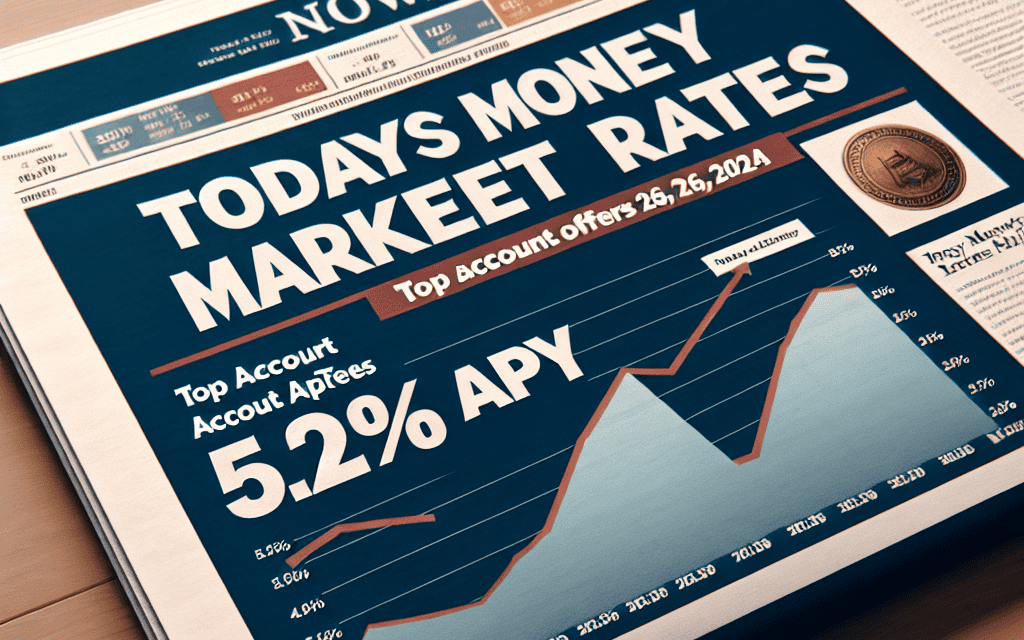“Maximize Your Savings: Secure 5.05% APY with Top Money Market Accounts Today!”
Introduction
As of October 26, 2024, money market accounts are presenting attractive opportunities for savers, with top account offers reaching an impressive 5.05% annual percentage yield (APY). These accounts, known for their blend of savings and checking account features, provide a secure and flexible option for individuals looking to maximize their returns while maintaining liquidity. The competitive rates reflect broader economic trends and monetary policies, making it an opportune time for consumers to explore these financial products. With varying terms and conditions across different financial institutions, it’s essential for savers to compare offerings to find the best fit for their financial goals.
Understanding Money Market Accounts: Key Features and Benefits
In the ever-evolving landscape of personal finance, money market accounts (MMAs) have emerged as a popular choice for individuals seeking a blend of savings and investment features. As of October 26, 2024, some of the top money market accounts are offering an impressive 5.05% annual percentage yield (APY), making them an attractive option for those looking to maximize their returns while maintaining liquidity. Understanding the key features and benefits of money market accounts can help potential investors make informed decisions about where to place their funds.
Money market accounts are a type of deposit account offered by banks and credit unions that typically provide higher interest rates than traditional savings accounts. This is primarily because MMAs invest in short-term, low-risk securities such as Treasury bills, certificates of deposit, and commercial paper. As a result, they offer a relatively safe investment vehicle with the added benefit of earning a competitive yield. The current rate of 5.05% APY is particularly noteworthy, as it reflects the broader trend of rising interest rates in the financial markets, providing an opportunity for account holders to benefit from increased earnings on their deposits.
One of the distinguishing features of money market accounts is their liquidity. Unlike certificates of deposit, which require funds to be locked in for a specified term, MMAs allow account holders to access their money with relative ease. This flexibility is particularly advantageous for individuals who may need to withdraw funds for unexpected expenses or who prefer to keep their savings accessible. However, it is important to note that federal regulations typically limit the number of certain types of withdrawals and transfers from MMAs to six per month. This limitation encourages account holders to use these accounts primarily for savings rather than frequent transactions.
In addition to competitive interest rates and liquidity, money market accounts often come with check-writing privileges and debit card access, further enhancing their convenience. These features make MMAs a versatile financial tool, suitable for both short-term savings goals and as a component of a diversified investment strategy. For instance, individuals saving for a down payment on a home or building an emergency fund may find the combination of higher yields and easy access particularly appealing.
Moreover, money market accounts are insured by the Federal Deposit Insurance Corporation (FDIC) for banks or the National Credit Union Administration (NCUA) for credit unions, up to the standard insurance amount of $250,000 per depositor, per institution. This insurance provides an additional layer of security, ensuring that account holders’ funds are protected in the unlikely event of a financial institution’s failure.
While the benefits of money market accounts are clear, potential investors should also consider any associated fees and minimum balance requirements. Some institutions may charge monthly maintenance fees or require a minimum deposit to open an account, which could impact the overall return on investment. Therefore, it is advisable to compare different offerings and carefully review the terms and conditions before committing to a particular account.
In conclusion, money market accounts represent a compelling option for individuals seeking a balance between earning potential and accessibility. With top accounts currently offering a 5.05% APY, they provide an opportunity to capitalize on favorable interest rates while enjoying the security and convenience of a liquid savings vehicle. By understanding the key features and benefits of MMAs, investors can make informed decisions that align with their financial goals and risk tolerance.
Comparing Money Market Account Rates: How 5.05% APY Stands Out
In the ever-evolving landscape of personal finance, money market accounts (MMAs) have emerged as a popular choice for individuals seeking a balance between liquidity and higher interest rates. As of October 26, 2024, the financial market has witnessed a notable shift, with some money market accounts offering an impressive 5.05% annual percentage yield (APY). This development prompts a closer examination of how such rates compare to other financial instruments and what factors contribute to their appeal.
To begin with, money market accounts are a type of savings account that typically offer higher interest rates than traditional savings accounts. They achieve this by investing in short-term, low-risk securities, which allows them to provide better returns while maintaining a high degree of liquidity. The current offering of 5.05% APY is particularly significant, as it surpasses the average rates provided by many other savings vehicles, including standard savings accounts and certificates of deposit (CDs). This makes MMAs an attractive option for those looking to maximize their returns without sacrificing access to their funds.
Moreover, the competitive rate of 5.05% APY stands out in the context of the broader economic environment. In recent years, interest rates have been subject to fluctuations due to various economic factors, including inflationary pressures and central bank policies. As a result, savers have been on the lookout for opportunities to protect and grow their wealth in a manner that outpaces inflation. Money market accounts offering such high yields provide a viable solution, as they not only offer competitive returns but also come with the added benefit of federal insurance, typically up to $250,000 per depositor, per institution.
In addition to their attractive interest rates, money market accounts offer several other advantages that contribute to their appeal. For instance, they often come with check-writing privileges and debit card access, features that are not commonly associated with traditional savings accounts. This level of accessibility makes MMAs a flexible option for individuals who require both the security of a savings account and the convenience of a checking account. Furthermore, the interest rates on money market accounts are usually variable, meaning they can adjust in response to changes in the broader interest rate environment, potentially leading to even higher returns in the future.
However, it is important for potential investors to consider the limitations and requirements associated with money market accounts. While the 5.05% APY is enticing, it is often contingent upon maintaining a minimum balance, which can vary significantly between financial institutions. Additionally, some accounts may impose fees for falling below the required balance or for exceeding a certain number of transactions per month. Therefore, it is crucial for individuals to carefully review the terms and conditions of any money market account they are considering to ensure it aligns with their financial goals and circumstances.
In conclusion, the current offering of a 5.05% APY on money market accounts represents a compelling opportunity for savers seeking to enhance their returns while maintaining liquidity. By providing a higher yield than many traditional savings options and offering features that enhance accessibility, MMAs have solidified their position as a valuable component of a diversified financial strategy. As always, individuals should conduct thorough research and consider their unique financial needs before committing to any financial product.
Top Banks Offering 5.05% APY on Money Market Accounts
In the ever-evolving landscape of personal finance, money market accounts have emerged as a popular choice for individuals seeking a balance between liquidity and higher interest rates. As of October 26, 2024, several top banks are offering competitive annual percentage yields (APY) on money market accounts, with some reaching as high as 5.05%. This development is particularly noteworthy for savers looking to maximize their returns while maintaining easy access to their funds.
To begin with, it is essential to understand what a money market account entails. Unlike traditional savings accounts, money market accounts typically offer higher interest rates in exchange for higher minimum balance requirements. They also provide the flexibility of limited check-writing capabilities and debit card access, making them an attractive option for those who desire both growth and accessibility. In the current economic climate, where interest rates have been on a gradual rise, these accounts have become increasingly appealing.
Among the financial institutions leading the charge with a 5.05% APY on money market accounts are several well-established banks known for their robust financial products and customer service. These banks have strategically positioned themselves to attract depositors by offering rates that significantly outpace the national average for savings accounts. This competitive edge not only benefits consumers but also reflects the banks’ confidence in their financial stability and market positioning.
Moreover, the decision to offer such attractive rates is influenced by a variety of factors, including the Federal Reserve’s monetary policy and the overall economic environment. As the Federal Reserve adjusts interest rates to manage inflation and stimulate economic growth, banks often respond by recalibrating the rates they offer on deposit accounts. Consequently, the current offering of 5.05% APY can be seen as a response to these broader economic conditions, providing consumers with an opportunity to capitalize on favorable market trends.
In addition to the appealing interest rates, these top banks also emphasize the security and reliability of their money market accounts. Most of these accounts are insured by the Federal Deposit Insurance Corporation (FDIC) up to the maximum allowable limit, ensuring that depositors’ funds are protected. This assurance of safety, combined with the potential for higher returns, makes money market accounts a compelling choice for risk-averse investors.
Furthermore, the accessibility of these accounts is enhanced by the digital banking platforms offered by many of these institutions. Customers can easily manage their accounts online, track their earnings, and make transactions with ease. This convenience, coupled with the competitive interest rates, underscores the value proposition of money market accounts in today’s financial landscape.
In conclusion, the current offering of 5.05% APY on money market accounts by top banks represents a significant opportunity for savers to enhance their financial portfolios. By providing a blend of high returns, security, and accessibility, these accounts cater to the needs of modern consumers who seek both growth and flexibility. As economic conditions continue to evolve, it will be interesting to observe how these rates adjust and how consumers respond to the changing financial environment. For now, those looking to make the most of their savings would do well to consider the advantages of these high-yield money market accounts.
How to Choose the Best Money Market Account for Your Needs

In the ever-evolving landscape of personal finance, selecting the right money market account (MMA) is crucial for maximizing your savings. As of October 26, 2024, some of the top money market accounts are offering an impressive 5.05% annual percentage yield (APY), making it an opportune time to evaluate your options. However, choosing the best account for your needs involves more than just comparing interest rates. It requires a comprehensive understanding of various factors that can influence your decision.
To begin with, it is essential to consider the financial institution offering the money market account. Established banks and credit unions often provide a sense of security and reliability, which can be reassuring for many investors. However, online banks have increasingly become competitive, frequently offering higher APYs due to their lower overhead costs. Therefore, it is advisable to research the reputation and stability of the institution, ensuring that it is insured by the Federal Deposit Insurance Corporation (FDIC) or the National Credit Union Administration (NCUA), which protects your deposits up to $250,000.
In addition to the APY, account fees are a critical factor to consider. Some money market accounts may have monthly maintenance fees, which can erode the interest earned. It is prudent to look for accounts that offer fee waivers if certain conditions are met, such as maintaining a minimum balance or setting up direct deposits. By doing so, you can ensure that your savings grow without unnecessary deductions.
Moreover, accessibility to your funds is another important consideration. Money market accounts typically offer check-writing privileges and debit card access, providing a level of liquidity that is not available with traditional savings accounts. However, federal regulations may limit the number of transactions you can make each month. Therefore, it is important to assess your financial habits and ensure that the account’s transaction limits align with your needs.
Furthermore, the minimum balance requirement is a significant aspect to evaluate. Some accounts may require a substantial initial deposit to open, while others might necessitate maintaining a certain balance to earn the advertised APY. It is crucial to choose an account that aligns with your financial situation, ensuring that you can comfortably meet any balance requirements without straining your finances.
Additionally, consider the customer service and digital tools offered by the financial institution. In today’s digital age, having access to a user-friendly mobile app or online banking platform can greatly enhance your banking experience. Efficient customer service is equally important, as it ensures that any issues or inquiries are promptly addressed.
Finally, it is beneficial to periodically review your money market account to ensure it continues to meet your financial goals. Interest rates and account terms can change, and staying informed allows you to make timely adjustments to your savings strategy.
In conclusion, while the allure of a high APY, such as the current 5.05%, is undeniable, selecting the best money market account requires a holistic approach. By considering factors such as the institution’s reputation, account fees, accessibility, minimum balance requirements, and customer service, you can make an informed decision that aligns with your financial objectives. As you navigate the options available, remember that the right money market account can serve as a valuable tool in your broader financial strategy, helping you achieve your savings goals with confidence.
The Impact of Interest Rates on Money Market Account Returns
In the ever-evolving landscape of personal finance, money market accounts (MMAs) have long been a favored choice for individuals seeking a balance between liquidity and higher interest rates. As of October 26, 2024, the financial market has witnessed a notable shift, with top money market account offers reaching an impressive 5.05% annual percentage yield (APY). This development prompts a closer examination of how interest rates impact the returns on these accounts and what it means for account holders.
To begin with, money market accounts are a type of savings account that typically offer higher interest rates compared to traditional savings accounts. They achieve this by investing in short-term, low-risk securities, such as Treasury bills and commercial paper. The interest rates on MMAs are closely tied to the prevailing economic conditions, particularly the Federal Reserve’s monetary policy. When the Federal Reserve adjusts its benchmark interest rates, it directly influences the rates that banks and financial institutions offer on their deposit accounts, including MMAs.
In recent times, the Federal Reserve has adopted a more aggressive stance in managing inflation, which has led to a series of interest rate hikes. These increases are designed to curb inflationary pressures by making borrowing more expensive and saving more attractive. Consequently, banks have responded by raising the interest rates on their deposit products, including money market accounts. This is why, as of late October 2024, we are witnessing some of the most competitive MMA rates in years, with top offers reaching 5.05% APY.
The impact of these elevated interest rates on money market account returns is significant. For account holders, higher APYs translate into greater earnings on their deposits. This is particularly beneficial for those who maintain substantial balances in their accounts, as the interest accrued can be a meaningful addition to their overall financial portfolio. Moreover, the liquidity feature of MMAs allows account holders to access their funds with relative ease, making them an attractive option for those who require both growth and flexibility in their savings strategy.
However, it is essential to consider the broader economic context when evaluating these attractive rates. While higher interest rates can enhance returns on savings, they also reflect underlying economic challenges, such as inflationary pressures and potential slowdowns in economic growth. Therefore, individuals must weigh the benefits of higher returns against the potential risks associated with a changing economic environment.
Furthermore, as interest rates fluctuate, so too can the rates offered on money market accounts. It is crucial for account holders to remain vigilant and regularly review their financial strategies to ensure they are optimizing their returns. This may involve comparing different financial institutions’ offerings and considering whether to lock in higher rates with other financial products, such as certificates of deposit, if they anticipate future rate declines.
In conclusion, the current landscape of money market account rates, highlighted by top offers of 5.05% APY, underscores the dynamic interplay between interest rates and financial returns. As individuals navigate this environment, understanding the factors driving these rates and their implications is vital for making informed financial decisions. By staying informed and proactive, account holders can effectively leverage the opportunities presented by today’s money market account rates to enhance their financial well-being.
Money Market Accounts vs. Savings Accounts: Which is Better?
In the ever-evolving landscape of personal finance, individuals are constantly seeking the most advantageous ways to grow their savings. As of October 26, 2024, money market accounts have garnered significant attention, particularly with top account offers boasting an impressive 5.05% annual percentage yield (APY). This development prompts a closer examination of money market accounts in comparison to traditional savings accounts, as savers strive to determine which option better suits their financial goals.
To begin with, it is essential to understand the fundamental differences between money market accounts and savings accounts. Both serve as vehicles for saving money while earning interest, yet they differ in terms of accessibility, interest rates, and account features. Money market accounts typically offer higher interest rates than standard savings accounts, as evidenced by the current 5.05% APY available in the market. This higher yield can be attributed to the account’s investment in short-term, low-risk securities, which allows financial institutions to pass on greater returns to account holders.
Moreover, money market accounts often provide more flexibility in terms of access to funds. Unlike savings accounts, which may limit the number of withdrawals or transfers per month, money market accounts frequently come with check-writing privileges and debit card access. This feature makes them an attractive option for individuals who desire both the ability to earn competitive interest and the convenience of liquidity.
However, it is important to consider the potential trade-offs associated with money market accounts. While they offer higher interest rates and greater accessibility, they may also require a higher minimum balance to open or maintain the account. This requirement can be a barrier for some savers, particularly those who are just beginning to build their financial reserves. In contrast, savings accounts generally have lower minimum balance requirements, making them more accessible to a broader range of individuals.
Furthermore, the decision between a money market account and a savings account should also take into account the individual’s financial objectives and risk tolerance. For those who prioritize maximizing their interest earnings and have the means to meet higher balance requirements, a money market account with a 5.05% APY could be an ideal choice. On the other hand, individuals who prefer a straightforward, low-maintenance savings option may find a traditional savings account more suitable.
In addition to these considerations, it is crucial to remain informed about the broader economic context and how it influences interest rates. The current high APY offered by money market accounts is reflective of prevailing economic conditions, including central bank policies and market demand for short-term securities. As these factors fluctuate, so too will the interest rates on both money market and savings accounts. Therefore, savers should regularly review their account options and remain adaptable to changes in the financial environment.
In conclusion, the choice between a money market account and a savings account hinges on a variety of factors, including interest rates, accessibility, minimum balance requirements, and individual financial goals. With today’s top money market account offering a 5.05% APY, it presents a compelling opportunity for those seeking to enhance their savings. Nevertheless, it is imperative for individuals to carefully assess their personal circumstances and financial objectives to determine which account type aligns best with their needs. By doing so, they can make informed decisions that will ultimately contribute to their long-term financial well-being.
Tips for Maximizing Returns on Your Money Market Account
In the ever-evolving landscape of personal finance, money market accounts (MMAs) have emerged as a popular choice for individuals seeking a balance between liquidity and higher interest rates. As of October 26, 2024, some of the top money market accounts are offering an impressive 5.05% annual percentage yield (APY), making them an attractive option for savers. To maximize returns on your money market account, it is essential to understand the nuances of these financial instruments and implement strategies that align with your financial goals.
First and foremost, it is crucial to shop around and compare different money market account offerings. Financial institutions vary significantly in the interest rates they provide, and even a small difference in APY can have a substantial impact on your returns over time. By conducting thorough research and comparing rates from various banks and credit unions, you can ensure that you are securing the most competitive rate available. Additionally, consider the reputation and stability of the institution, as these factors can influence the security of your deposits.
Once you have selected a money market account with a favorable APY, it is important to maintain a balance that maximizes your interest earnings. Many accounts offer tiered interest rates, meaning that higher balances may qualify for higher APYs. Therefore, it is beneficial to keep your balance above any thresholds that trigger increased rates. However, be mindful of any minimum balance requirements to avoid incurring fees that could negate your interest earnings.
Moreover, taking advantage of compound interest is a key strategy for maximizing returns. Money market accounts typically compound interest daily or monthly, allowing your earnings to grow at an accelerated rate. To fully benefit from this compounding effect, it is advisable to leave your interest earnings in the account rather than withdrawing them. This approach allows your interest to earn additional interest, thereby enhancing your overall returns.
In addition to these strategies, it is wise to regularly review and reassess your money market account. Financial markets and interest rates are subject to change, and what may have been a competitive rate at one time could become less attractive as new offers emerge. By staying informed about current market conditions and periodically evaluating your account, you can make informed decisions about whether to maintain your current account or switch to one with a more favorable rate.
Furthermore, consider the role of a money market account within your broader financial portfolio. While MMAs offer higher interest rates than traditional savings accounts, they may not provide the same growth potential as other investment vehicles such as stocks or bonds. Therefore, it is important to align your use of a money market account with your overall financial strategy, ensuring that it complements your risk tolerance and long-term objectives.
In conclusion, maximizing returns on your money market account requires a combination of strategic planning and ongoing vigilance. By selecting an account with a competitive APY, maintaining an optimal balance, leveraging compound interest, and staying informed about market trends, you can enhance your earnings and make the most of this versatile financial tool. As you navigate the complexities of personal finance, a well-managed money market account can serve as a valuable component of your financial strategy, providing both security and growth potential in an ever-changing economic environment.
Q&A
1. **What is the highest APY offered for money market accounts as of October 26, 2024?**
The highest APY offered is 5.05%.
2. **Are there any fees associated with the top money market accounts?**
Many top money market accounts have minimal or no monthly fees, but it’s important to check specific account terms.
3. **What is the typical minimum deposit required for these high-yield money market accounts?**
Minimum deposit requirements can vary, but they often range from $0 to $10,000.
4. **How do money market accounts compare to savings accounts in terms of interest rates?**
Money market accounts typically offer higher interest rates compared to traditional savings accounts.
5. **Are money market accounts FDIC insured?**
Yes, money market accounts offered by banks are generally FDIC insured up to $250,000 per depositor, per bank.
6. **Can you write checks from a money market account?**
Yes, many money market accounts allow check-writing privileges, though there may be limits on the number of transactions.
7. **What factors should be considered when choosing a money market account?**
Consider the APY, fees, minimum deposit requirements, withdrawal limits, and whether the account is FDIC insured.
Conclusion
As of October 26, 2024, money market account rates have reached a competitive level, with top offers providing an annual percentage yield (APY) of 5.05%. This rate reflects a favorable environment for savers seeking to maximize their returns on liquid assets. The increase in APY suggests a response to broader economic conditions, possibly including inflationary pressures and monetary policy adjustments. Savers should consider these high-yield options as a means to enhance their savings strategy, balancing the benefits of higher returns with the liquidity and safety typically associated with money market accounts.





